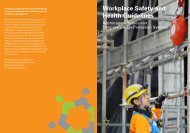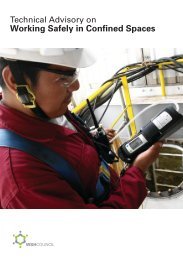Code of Practice - Workplace Safety and Health Council
Code of Practice - Workplace Safety and Health Council
Code of Practice - Workplace Safety and Health Council
Create successful ePaper yourself
Turn your PDF publications into a flip-book with our unique Google optimized e-Paper software.
persons from coming under the suspended load. Such measures could include deployment <strong>of</strong> more<br />
signalmen to guide the load or installing audible alarm to warn workers about the on-going lifting<br />
operation.<br />
2.4.5 Environment – this refers to the weather conditions such as heavy rain, haze or glaze which<br />
impact the visibility <strong>of</strong> the lifting crew. Other weather conditions which could directly impact the stability<br />
<strong>and</strong> safety <strong>of</strong> the lifting operations include strong winds, thunderstorms or lightning situation. It is<br />
important to note that wind speed is stronger at higher grounds. During the planning <strong>of</strong> any lifting<br />
operation, the anticipated wind speeds at the site must be considered <strong>and</strong> made reference to the crane<br />
manufacturer operation manual on the wind speed limit. It is always advisable to stop all lifting<br />
operations when the weather condition deteriorates.<br />
2.5 Man<br />
Investigation into past accidents revealed that human error is the most common causes <strong>of</strong> accidents<br />
involving lifting operations. Therefore, it is paramount that every single member <strong>of</strong> the lifting crew<br />
(operator, rigger, signalman <strong>and</strong> lifting supervisor) is adequately trained <strong>and</strong> competent to carry out his<br />
duties properly. They must also be fully conversant with the actual lifting procedures applicable for that<br />
lifting operation <strong>and</strong> not just the generic procedures. The following are some <strong>of</strong> the factors that should<br />
be considered:<br />
2.5.1 Fit for duty – besides the pre-requisite <strong>of</strong> competency (such as ability to read load capacity<br />
charts), the fitness <strong>of</strong> the personnel, such as any existing medical conditions or length <strong>of</strong> working hours<br />
that could adversely affect his ability to discharge his duties must also be considered.<br />
2.5.2 Roles <strong>and</strong> Responsibility – these must be clearly spelt out to the individuals involved in the<br />
lifting operations. There must be clear leadership within the lifting crew such that instructions are<br />
appropriately relayed. In addition, all personnel must be empowered to stop work if they see or believe<br />
that the operation is or has become unsafe.<br />
2.5.3 Communications – this refers not only to the provision <strong>of</strong> communication devices such as<br />
radio walkie-talkie or application <strong>of</strong> st<strong>and</strong>ard h<strong>and</strong> signals, but also ensuring that there is common<br />
underst<strong>and</strong>ing between members <strong>of</strong> the lifting crew. Employers must consider the composition <strong>of</strong> the<br />
lifting crew taking into consideration that the local workforce comprises workers from various countries<br />
with different languages <strong>and</strong> cultures.<br />
Further explanation is provided in Section 5 <strong>of</strong> this CP.<br />
2.6 Method<br />
Most general type <strong>of</strong> lifting operations rely on established procedures after taking into consideration<br />
factors such as Machine, Medium <strong>and</strong> Man as previously discussed. These types <strong>of</strong> lift are typically<br />
Page 11 <strong>of</strong> 38

















